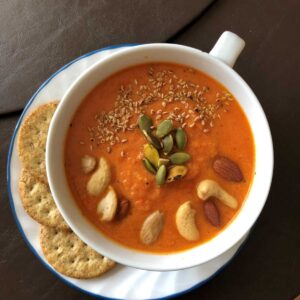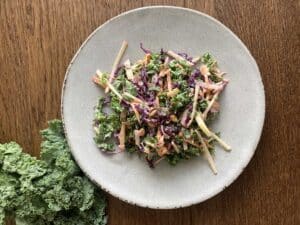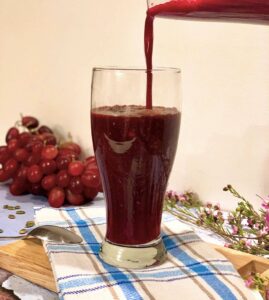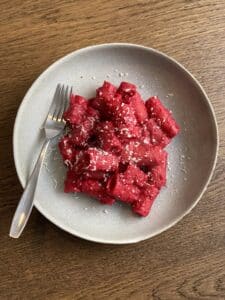Knowing the foods rich in nitric oxide foods can benefit heart health.
Nitric oxide is a molecule that plays a crucial role in cardiovascular health, helping to relax and widen blood vessels, lower blood pressure, and improve blood flow.
While there are many ways to support nitric oxide production in the body, including regular exercise and stress management techniques, diet can also play a significant role. Some foods are particularly rich in nutrients that can boost nitric oxide levels, while others can inhibit its production.
Read on to learn how to reduce your risk of cardiovascular disease by including some of the best nitric oxide-rich foods in your diet, as well as learning what foods to avoid.
Top Takeaways
- Nitric oxide is essential for cardiovascular health as it relaxes blood vessels, lowers blood pressure, and improves blood flow.
- Diet can impact nitric oxide production, and some foods, such as beets, leafy greens, and citrus fruits, are rich in nutrients that boost nitric oxide levels.
- Foods high in saturated and trans fats, refined carbohydrates, and processed foods can reduce nitric oxide production and should be limited in a heart-healthy diet.
- Maintaining a balanced diet, including nitric oxide-rich foods and avoiding harmful ones, can contribute to overall cardiovascular health and should be part of a comprehensive health plan.
Note: It’s important to consult with a healthcare provider for personalized advice on maintaining cardiovascular health.
Pin It For Later
What is Nitric Oxide?
Nitric oxide is a signaling molecule produced by the cells in our body that play a crucial role in regulating various physiological processes, including blood pressure, immune function, and neurotransmission.
Nitric oxide is a vasodilator, which means it helps to relax the blood vessels and increase blood flow to various organs and tissues in the body (1). This increased blood flow can lead to improved cardiovascular health, cognitive function, and exercise performance. Nitric oxide is also involved in the immune response and helps to fight off infections (1).
Including nitric oxide in your diet can help to increase the production of this important signaling molecule, which can have positive effects on various aspects of your health.
However, it is important to note that while consuming nitric oxide-rich foods can help increase nitric oxide production, the effects may vary depending on individual factors such as genetics, age, and overall health status.
How Does Nitric Oxide Help With Heart Disease?
Nitric oxide has many health benefits. It plays an important role in regulating cardiovascular function. Deficiencies in nitric oxide production have been linked to the development of cardiovascular diseases, including coronary heart disease and heart attacks(1).
Nitric oxide helps to regulate blood pressure by relaxing the smooth muscle cells in the walls of the blood vessels, which leads to vasodilation and improved blood flow. This helps to decrease the workload on the heart, reducing the risk of hypertension and other cardiovascular conditions.
Nitric oxide also helps to prevent the formation of blood clots and plaque buildup in the arteries, which can lead to atherosclerosis and other cardiovascular complications. Thus, unclogging arteries. By promoting vasodilatation and reducing inflammation, nitric oxide helps to maintain the health of the endothelial cells that line the blood vessels, which is crucial for overall cardiovascular health (2).
Studies have shown that increasing nitric oxide production through diet and supplementation can have positive effects on various aspects of cardiovascular health, including reducing blood pressure, improving endothelial function, and reducing the risk of heart disease (3).
However, most information is from small studies and more research is needed to fully understand the role of nitric oxide in cardiovascular disease, and determine the optimal levels of nitric oxide for maintaining cardiovascular health.
In summary, the benefits of nitric oxide foods are:
- Improved blood flow and oxygen delivery
- Lowered blood pressure
- Reduced inflammation

13 Foods Rich In Nitric Oxide
The amount of nitric oxide in each food, as well as how much these foods increases nitric oxide production can vary depending on various factors. These factors include the amount of the food consumed, the individual’s overall health status, and other factors. Check out this list of foods rich in nitric oxide with some great recipe ideas that raise nitric oxide levels!
Be sure to download the FREE foods rich in nitric oxide food list at the end of this section that summarizes which foods to include more of to increase nitric oxide in the body.
Tomatoes
Tomatoes are foods rich in nitric oxide because of they are high in an antioxidant called lycopene. This antioxidant has been shown to improve nitric oxide production and blood vessel function (4). Check out this protein tomato soup recipe.

Turmeric
Turmeric contains a compound called curcumin, which has anti-inflammatory effects, and increasing nitric acid in foods can help improve nitric oxide production in the body (5). Try this fantastic turmeric energy ball recipe.

Cabbage
Cabbage is rich in nitrates, which can be converted into nitric oxide in the body and this is one of the best foods for nitric oxide production (6). Use cabbage in this kale apple slaw.

Onions
They are a nitric oxide-rich food that is high in sulfur compounds that can help to stimulate the production of nitric oxide (7). Onions are a staple in the list of low-cholesterol foods too.
Celery
Celery is also a food that is high in nitrates and can help to improve nitric oxide production and blood vessel function. Use it when making heart-healthy fish cakes without potato.

Green tea
Green tea is a food rich in nitric oxide as it contains compounds called catechins, which have been shown to increase nitric oxide production and improve blood flow (8). These results place green tea on par with other foods that are high in nitric oxide.
Beets
Beets are one of the most potent nitric oxide-boosting foods, as they are high in nitrates that can be converted into nitric oxide in the body.
Studies have shown that consuming beetroot juice or beets can significantly increase nitric oxide levels in the blood and improve blood flow (9). This makes beets the best food for nitric oxide. Include them in this beet smoothie to lower blood pressure, beet green smoothie, or this beet mac and cheese recipe, without the taste of beet being overpowering.
Dark Leafy Greens
Green leafy vegetables such as spinach, arugula, Swiss chard, Bok choy, and kale contain high levels of nitrates. These have a positive effect, increasing nitric oxide production in the body (10). Try using them in this pesto butter salmon recipe.

Garlic
Garlic is a food that raises nitric oxide levels because it contains a compound called allicin. Allicin can help to increase nitric oxide production and improve blood vessel function (11). Find it in this low-sodium pizza sauce recipe.

Citrus Fruits
Citrus fruits are foods rich in nitric oxide. Oranges, grapefruits, and lemons are considered nitric oxide fruits. They are high in vitamin C, which can help to improve nitric oxide production and blood flow (12). Try it in this pineapple cucumber ginger lemon weight loss water.

Pomegranate
Pomegranate is one of the top nitric oxide fruits. It is rich in antioxidants, which can help to improve nitric oxide production and blood vessel function (13). You can include it in this juice recipe to lower cholesterol.
Dark Chocolate
Dark chocolate is considered one of the foods rich in nitric oxide as it contains flavanitric oxides. This can help to increase nitric oxide production and improve blood flow (14). You will love using this in my low-sodium hot chocolate recipe.

Nuts and Seeds
Nuts and seeds such as almonds, walnuts, hemp, and chia seeds are foods with high nitric oxide. They are full of plant-based proteins and rich in arginine, an aminitric oxide acid that can help to increase nitric oxide production in the body (15). Try them in this chia seed coffee.

To make it simple, I’ve compiled a list of foods rich in nitric oxide and ways of increasing nitric oxide intake in a healthy diet.
| Foods Rich In Nitric Oxide | Examples | Easiest Ways To Include Them |
| Turmeric | Fresh turmeric root, turmeric powder | Add turmeric to soups, stews, and curries, or mix into smoothies or tea |
| Tea | Green tea, black tea | Brew a cup of tea and enjoy hot or cold, or use as a base for a refreshing iced tea |
| Beets | Beet juice, roasted beets, beet salad | Add beet juice to smoothies, roast beets and use them in salads or as a side dish |
| Leafy Green Vegetables | Spinach, kale, arugula | Use as the base for salads or add to smoothies |
| Garlic | Raw garlic, roasted garlic, garlic powder | Add to sauces, dressings, and marinades, or mix into mashed potatoes |
| Citrus Fruits | Oranges, grapefruit, lemons | Squeeze fresh citrus juice into water, salads, or marinades |
| Pomegranates | Pomegranate juice, fresh pomegranate seeds | Use pomegranate juice as a base for salad dressings or add fresh pomegranate seeds to salads or yogurt |
| Nuts and Seeds | Pistachios, almonds, walnuts, chia seeds | Snack on nuts, sprinkle seeds on top of salads or oatmeal, or add to smoothies |
| Dark Chocolate | Dark chocolate bars, cocoa powder | Enjoy as a dessert or snack, or add cocoa powder to smoothies or oatmeal |
Table: The best nitric oxide foods and how to include them in an eating pattern.
Be sure to download the best nitric oxide food list here for a take-home summary about foods with high nitric oxide.
Foods That Reduce Nitric Oxide
Yes, there are some foods that can reduce nitric oxide production in the body (16). Here are a few examples:
Foods High In Saturated And Trans Fats
These types of fats can decrease the activity of nitric oxide synthase, the enzyme that produces nitric oxide in the body. Examples include fatty cuts of meat, butter, full-fat dairy products, and fried foods. These are also foods to avoid with stroke.
Foods High In Refined Carbohydrates And Sugar
Consuming too much refined carbohydrates and sugar can lead to insulin resistance and inflammation, which can impair nitric oxide production. Examples include white bread, white rice, candy, soda, and other sugary drinks.
Alcohol
Chronic alcohol consumption has been shown to reduce nitric oxide bioavailability in the body, which can impair vascular function.
Processed Foods
Many processed foods contain high amounts of sodium, which can lead to high blood pressure and impair the production and availability of nitric oxide in the body.
While it’s important to limit these types of foods in your diet, it’s also important to remember that a balanced and varied diet that includes plenty of whole foods, fruits, vegetables, and lean protein sources can help support nitric oxide production and overall cardiovascular health.
Think Mediterranean diet, DASH diet, Portfolio diet, and Mind diet ways of eating.
Final Thoughts
Maintaining healthy levels of nitric oxide is an important part of overall cardiovascular health, and diet can play a significant role in supporting its production. That’s why this list of best nitric oxide foods is so valuable. Don’t forget to download yours here!
By including the foods rich in nitric oxide in your diet, such as leafy greens, beets, and citrus fruits, and avoiding foods that can inhibit nitric oxide production, like those high in saturated and trans fats and refined carbohydrates, you can help support optimal nitric oxide levels and promote heart health.
As always, it’s important to work with your healthcare provider to develop a comprehensive plan for maintaining cardiovascular health, which may include diet modifications, exercise, and other lifestyle changes.
I’d love to hear from you. Let me know your favorite food that is rich in nitric oxide and how you use it below.




